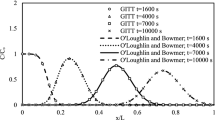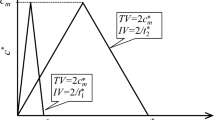Abstract
Laplace transformation was used to derive an analytical solution for a one-dimensional advection–diffusion equation with exponential pollution source terms. Additionally, a numerical solution was obtained for two coupled advection–diffusion equations for the concentrations of pollutants and dissolved oxygen using an explicit finite difference scheme. In this study, it is assumed that the river has a uniform solute concentration prior to the injection of pollutants. At the origin, the input pollutant concentration source may increase over time for various reasons and the assumption is made that the concentration gradient approaches zero at \(x \to \infty\). The parameters that have a role in reducing the concentration of pollutants along the river have been studied in detail with the help of figures. This simple model facilitates an understanding of the pollution-aeration process and its relationship to injected pollution along a river. The study discusses a straightforward procedure aimed at regulating farming, industrial, and urban practices, and imposing restrictions if necessary. With accuracy, this study determines the intervals within the river where fish can survive at a given time, along the river with the maximum permissible water velocity and the minimum permissible oxygen transfer from air to water. This study mathematically proves the fact that high pollutant concentrations can be reduced by increasing the concentration of dissolved oxygen.








Similar content being viewed by others
Data availability
The data from this study is only presented in this article to support the results.
References
Anderson JD Jr (1995) Computational fluid dynamics. McGraw-Hill, New York
Crank J (1975) The mathematics of diffusion, 2nd edn. Oxford University Press, London
Dimain MFA, Ibrahim FN, Wadi AS (2013) The effect of added pollutant along a river on the pollutant concentration described by one-dimensional advection diffusion equation. Int J Eng Sci Technol 5:1662–1671
Hadhouda MKh, Hassan ZS (2022) Mathematical model for unsteady remediation of river pollution by aeration. Inf Sci Lett 11:323–329
Ibrahim FN, Dimain MF, Wadi AS (2015) Remediation of pollution in a river by unsteady aeration with arbitrary initial and boundary conditions. J Hydrol 525:793–797
Ibrahim F, Saleh A, Wadi A, Hadhouda M (2022) Remediation of pollution in a river by releasing clean water using the solution of advection-diffusion equation in two dimensions. Inf Sci Lett 11:1385–1392
Kumar A, Jaiswal DK, Kumar N (2009) Analytical solutions of one-dimensional advection-diffusion equation with variable coefficients in a finite domain. J Earth Syst Sci 118:539–549
Manitcharoen N, Pimpunchat B (2020) Analytical and numerical solutions of pollution concentration with uniformly and exponentially increasing forms of sources. J Appl Math 2020(3):1–9
Pimpunchat B, Sweatman WL, Triampo W, Wake GC, Parshotam A (2009) A mathematical model for pollution in a river and its remediation by aeration. App Math Lett 22:304–308
Pimpunchat B, Sweatman WL, Triampo W, Wake GC, Parshotam A (2007) Modelling river pollution and removal by aeration. In: Oxley L, Kulasiri D (eds) MODSIM 2007 international congress on modelling and simulation. land, water & environmental management: integrated systems for sustainability. Modelling and Simulation Society of Australia and New Zealand, December 2007, pp 2431–2437
Raafat PB, Ibrahim FN, Saleh A (2023) On determining conditions and suitable locations for fish survival by using the solution of the two coupled pollution and aeration equations. Sci Rep. https://doi.org/10.1038/s41598-023-33368-9
Saleh A, Ibrahim FN, Hadhouda MKh (2022a) Remediation of pollution in a river by releasing clean water. Inf Sci Lett 11:127–133
Saleh A, Ibrahim F, Hadhouda M (2022b) Analytical and numerical water quality model for a sinusoidally varying pollutant discharge concentration. Inf Sci Lett 11:1329–1334
Shukla VP (2002) Analytical solutions for unsteady transport dispersion of periodic waste discharge concentration nonconservative pollutant with time-dependent. J Hydraul Eng 9:866–869
Wadi AS, Dimian MF, Ibrahim FN (2014) Analytical solutions for one-dimensional advection-dispersion equation of the pollutant concentration. J Earth Syst Sci 123(6):1317–1324
Yadav RR, Kumar LK (2021) Analytical solution of two-dimensional conservative solute transport in a heterogeneous porous medium for varying input point source. Environ Earth Sci. https://doi.org/10.1007/s12665-021-09584-9
Zoppou C, Knighe JH (2009) Analytical solutions are provided for the one-dimensional transport of a pollutant in an open channel with steady unpolluted lateral inflow uniformly distributed over its whole length. J Hydraul Eng 132(2):144–148
Funding
The authors declare that no funds, grants, or other support were received during the preparation of this manuscript.
Author information
Authors and Affiliations
Contributions
AS: Data curation, software, formal analysis, writing manuscript. FNI: Formal analysis, validation, supervision, project administration. MAMS: Software, formal analysis, visualization. All authors have approved the final article.
Corresponding author
Ethics declarations
Conflict of interest
The authors declare that they have no known competing financial interests or personal relationships that could have appeared to influence the work reported in this paper.
Additional information
Publisher's Note
Springer Nature remains neutral with regard to jurisdictional claims in published maps and institutional affiliations.
Rights and permissions
Springer Nature or its licensor (e.g. a society or other partner) holds exclusive rights to this article under a publishing agreement with the author(s) or other rightsholder(s); author self-archiving of the accepted manuscript version of this article is solely governed by the terms of such publishing agreement and applicable law.
About this article
Cite this article
Saleh, A., Ibrahim, F.N. & Sharaf, M.A.M. Mathematical model for expanding suitable areas for fish survival in a polluted river by using the solution of the two coupled pollution and aeration equations. Model. Earth Syst. Environ. 10, 1803–1813 (2024). https://doi.org/10.1007/s40808-023-01868-2
Received:
Accepted:
Published:
Issue Date:
DOI: https://doi.org/10.1007/s40808-023-01868-2




